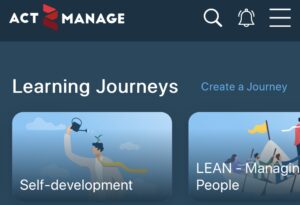To move one step further, we asked what kind of digital tools they use for this purpose. 50% mentioned e-learning courses, 32% referred to social learning platforms and 18% indicated mobile-learning. So even in a region that is technologically advanced, the majority of companies are still only talking about digitalization, and e-learning is the most typical solution. However, when we asked them about their experience with e-learning, L&D people did not get very excited. At the same time, everyone agrees that digitalization is a necessity. There is no other way to scale up and reach a wider participant base at a reasonable cost.
We discussed 10 current trends that we have observed over the last couple of years in the digitalization initiatives of learning and development activities:
1. From e-learning to mobile learning
If you check the visitor analytics of any website, you will see that the majority of content consumption nowadays happens through mobile devices, not desktop computers. Therefore, if learning content developers want to go where the audience is, they must provide mobile solutions. It is apparent, however, that people use mobile devices very differently from laptops, both in terms of time and place. Screen size also matters, therefore you can not simply shove your existing e-learning materials into a mobile platform. People are not going to scroll down for hours to read long articles, and they are unlikely to watch lengthy videos. There is a need for a completely new approach in digital teaching methodology. It has to fit the specific requirements of mobile learning.
2. From courses to on-demand support
People these days are used to getting instant responses to their information needs. Google will get you relevant search results in less than a second. When faced with a people management issue, you want some quick inspiration, a couple of actionable ideas or maybe just a bit of reinforcement to get going as soon as possible. Reading a full book or going through an online course that covers the subject is not something that you wish to do at that moment.
3. From company driven to self-directed
Training at work has largely been driven by the employer. However, if we are talking about on-demand learning, it becomes self-directed. You want support when and where you actually encounter a problem. This way, application comes right after learning, not weeks or even months later.
4. From knowledge transfer to developing skills
The first digital learning tools primarily focused on transferring knowledge. Behavioural change, however, requires more than just providing information. Adults tend to learn from experience, therefore, they need to try out in practice whatever they learned, reflect on their experience and modify behaviour accordingly. If you wish to go digital in soft skills development as well, you have to design solutions that do not only offer new knowledge but assists users in implementing it.
5. From full topics to microlearning
When we are talking about a self-directed, on-demand approach, we arrive at the notion of microlearning. In a problem situation, you may only need a reminder, some food for thought or an actionable idea, not theory or deep explanation. With microlearning, in a few minutes, you can pick up the key information and commit to specific action.
6. From complex and attractive to simple and practical
While e-learning programs tend to cover broad topics and present information in a sexy way (detailed text, videos, podcasts, infographics), these formats do not lend themselves to mobile microlearning. If you want your program participants to actually use your application, content needs to be boiled down to the essentials, offering simple, easy to understand, practical assistance for problems at hand.
7. From motivation to pass the test to gamification
The principal motivation to complete an online course used to be just passing the test at the end. We see a trend moving towards harnessing self-motivation, which can be enhanced by gamification. While not everybody is a gamer, it is surprising how many managers seem to be driven to jump levels, collect points and badges, and win off-line rewards linked to in-app challenges.
8. From memory testing to helping the application of new knowledge
Testing if you can remember what you read or heard about will not result in behavioural change or skills development. New digital learning tools have to make one further step and proactively help users try out what they learned. Action steps or commitments ensure that knowledge gets transferred into real life situations.
9. From one-off downloading to reminders and follow-up
It is not enough to determine action steps or make commitments. These have to be revisited and followed up to ensure that plans are executed and there is reflection on experience. If something proves to be working well for you, it has a good chance to become a habit.
10. From data about what was completed to data about what’s hot
Digital tools all collect data that you can analyse. In the past, you could mainly see what was actually completed, and what test results are. When we are talking about self-directed learning, we can also examine evidence about what users are interested in, what the hot topics are in the organization. We can also idenfify top users who are self-motivated and are willing to invest time in their personal development.
Digitalization seems to be an unstoppable trend in the global business community. It is still in its infancy, but those companies who pioneer will develop a competitive advantage.
Act2Manage Application
An interactive, gamification-based, practice-oriented leadership development application that provides immediate help and enables follow-up to the most common dilemmas.






